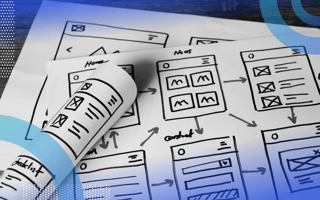User flows are critical because, as we build a product, we need to understand how different users engage with the same product. Is there a particular flow we think users should follow in order to maximize their use of our system? We can think of this as the happy path to value. How do we want a user to actually use our product and how can we design it so they will?
User flows are usually the responsibility of both the product manager and UX designer. The product manager often takes charge of understanding the problem set the team has to tackle. Product managers also should, through stakeholder management, understand the viability of the change we want the user to make.
The UX designer, on the other hand, is in charge of the path’s usability. How can someone get from point A to point B in a way that makes sense to them and the system itself? We’ve built this product. Now, how does someone get value from what we’ve created?
User Flows vs. User Journey
Why Are User Flows Important?
User flows are important because they help a product development team understand how the user actually uses the system. We have our hypotheses, of course, which should drive what we build. That said, we can’t know how our users will interact with the system until the product is out in the market.
User flows are important artifacts to mark our hypotheses along the way. Good user flows help identify what we’re thinking and how data will change our perception of the flow. In other words, they are a great way to help us understand when we’re wrong and what we can fix to drive value for our users.
How to Build User Flows
To build a user flow, ask yourself these questions:
- How do we define the user? How do we know this is the right user to go through this process?
- What is the action or change you want the user to experience while going through this process?
- What affects the user’s experience?
- What are the steps between the entry into the system and the exit from the system?
- How will we know when we’re wrong?
Some good resources to get you started include:
- The Beginner’s Guide to User Flow in UX Design | 2022 | by Annie Dai: This article will help you get started with tools to complete your first user flow.
- What are User Flows? | Interaction Design Foundation (IxDF): The IxDF gives a path for deeper learning through classes and extra literature to get into the ins and outs of user flows.
User Flow and User Journey: What’s the Difference?
The difference between user flow and user journey tends to come down to scale. A user flow looks at the actions the user takes through your product. It’s is a contained set of actions that have a clearly defined beginning and end. User journeys are focused on the value the user is looking for, whether they get it inside or outside the system you’ve created. User journey maps are not only focused on the steps a user takes but also explores their thoughts and feelings about the process.
Think of it this way: You use a map app on your phone to reach your destination but you use your calendar to look at your destinations throughout the day. Your calendar helps you understand your priorities and your map helps you get there. Your map is the user flow and your calendar is the user journey. The user flow tells you where you’re going but the user journey helps you understand your priorities along the way.
Ways to Improve a User Flow
User flows are a great way to keep your product user-centric. By having a clear understanding of what a successful flow looks like for the user’s experience, you can rally your team around the product and help them understand its value to users. The user flow gives you a place to adjust and evolve your product.
That said, user flows become a waste of time if you don’t revisit them throughout the development process. Take a moment to ensure you’re making time to come back to releases at least once per quarter and see if they’re driving your overall product strategy. If you aren’t checking in, they become a waste of time and the entire team checks out.





